
(Halyzia sedecimguttata)
Description
The orange lady beetle (also known as ladybirds or ladybugs) has between 14 and 16 cream-white spots on its orange wing case. They grow to 6mm long and have a yellow-orange head and orange legs. The edge of their shell is transparent.
In their larval stage, they are yellow-white with yellow stripes and black spots.

Distribution and Interactions
Orange lady beetles were once associated with ancient woodlands but may now be found in deciduous woodland where there are sycamore or ash trees. They eat leaves, and mildew that grows on ash and sycamore trees, as well as small aphids. In the winter, they hibernate in the leaf litter.
These beetles can be found throughout most of the UK but are more common in the South. They may be seen between April and October.


Folklore
Although there is not much folklore surrounding orange lady beetles specifically (perhaps due to their former rarity), lady beetles (especially the seven-spot lady beetle seen here) are more heavily featured in folklore. Several cultures consider lady beetles to bring good luck or to promise future love.
They are also used as biological pest control against aphids.
RELATED POSTS
View all


